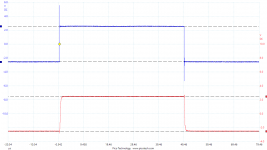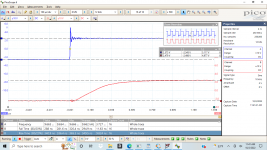Of coarse. Wouldn't be good for the tweeters. I didn't mean listening impressions but impressions after using it. Still haven't had time unfortunately.
This looked so easy I just had to try it on a solderless breadboard with a SN74AHC14N, using 1kOhm and 150nF to set the frequency. I used local lm317 and lm337 regulators to produce ~+/- 2.5V (330Ohm resistors all-around) from +/- 15. The top blue trace is the output of the inverter itself measured on a 200 MHz scope (but with the normal 6" ground lead, wires everywhere on the breadboard, etc). As others noted it can ring a lot (either in reality or in the measurement) if you aren't careful, which I wasn't. I then pushed the output through a simple first-order low-pass filter (1kOhm, 220pF) and into a TL072 voltage-follower to slow it down a bit; the red trace is the output of the TL072. The output of the op amp does look more usable - closer to what you would get out of a 1 MHz function generator, although the rising and falling edges aren't symmetric. I wonder if other opamps have better behavior when run this way? In any case I suspect it would need to be soldered-up in order to really understand how well it can work.Found another one-buck square-box with symmetry and with DC coupling.
View attachment 1093278
The R & C values are same as explained above or online.
The missing pin number is 12.
I just noticed the publication date; I don't think this is a joke.
Here is a zoom-in of the rising edge with the scope in full-bandwidth mode:
and here with the scope's 20 MHz bandwidth limit engaged
Usability of course depends on what you want to measure, but it was certainly fun to play with.
Jason
Attachments
So I ended up getting the signal generator that I ordered quite a while ago. The unit I received had an issue with the main board. They sent out another and I replaced it. I finally got around to using it and It works great!
So I am happy to finally have a nice clear square wave to check for oscillations. Thank you for the recommendations guys.
So I am happy to finally have a nice clear square wave to check for oscillations. Thank you for the recommendations guys.


